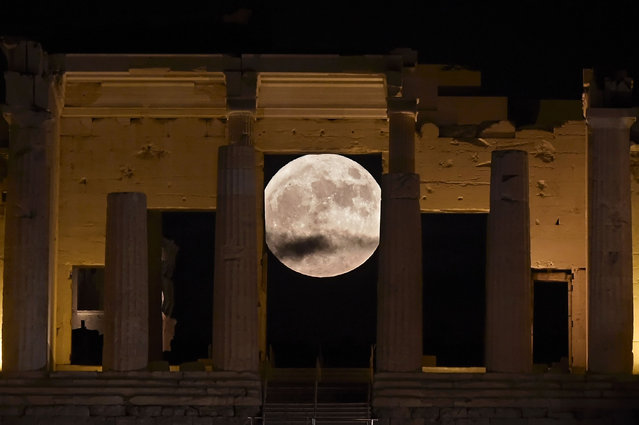
The “Supermoon” rises behind the Propylaea above the Ancient Acropolis hill in Athens on November 14, 2016. The moon will be the closest to Earth since 1948 at a distance of 356,509 kilometres (221,524 miles), creating what NASA described as “an extra-supermoon”. (Photo by Aris Messinis/AFP Photo)
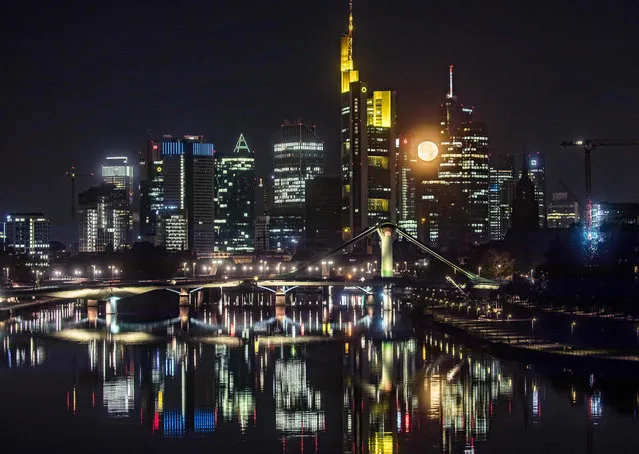
The sinking moon shine in the early morning hours, casting a glow on the sky line of Frankfurt, Germany, 14 November 2016. The moon is closer to the earth than ever, appearing very large. (Photo by Frank Rumpenhorst/DPA)
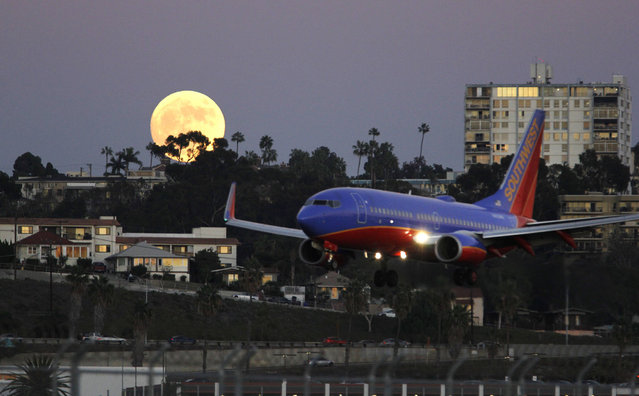
A Southwest Airlines Flight arrives at San Diego's Lindbergh Field as the Super Moon rises in the East on November 13, 2016 in San Diego, California, U.S. (Photo by John Gastaldo via ZUMA Wire)
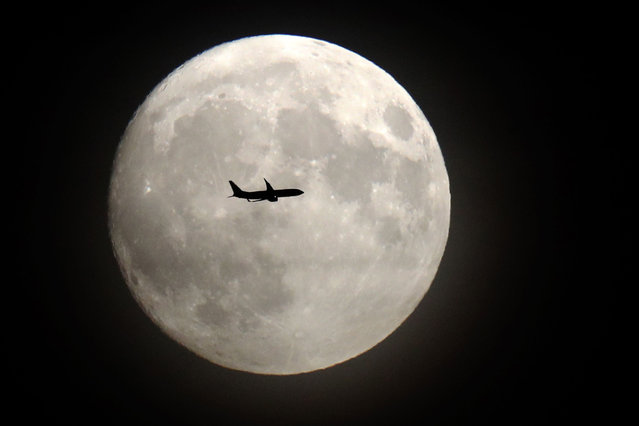
A commerical jet flies in front of the moon on its approach to Heathrow airport in west London on November 13, 2016. Tomorrow, the moon will orbit closer to the earth than at any time since 1948, named a “supermoon”, it is defined by a Full or New moon coinciding with the moon's closest approach to the Earth. (Photo by Adrian Dennis/AFP Photo)
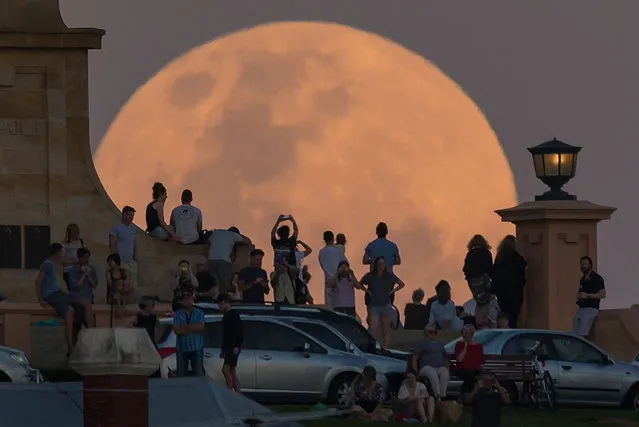
Crowds look on as the super moon rises behind the Fremantle War Memorial at Monument Hill on November 14, 2016 in Fremantle, Australia. A super moon occurs when a full moon passes closes to earth than usual, with the November 14th moon expected to be closer than it has been in over 70 years. (Photo by Paul Kane/Getty Images)
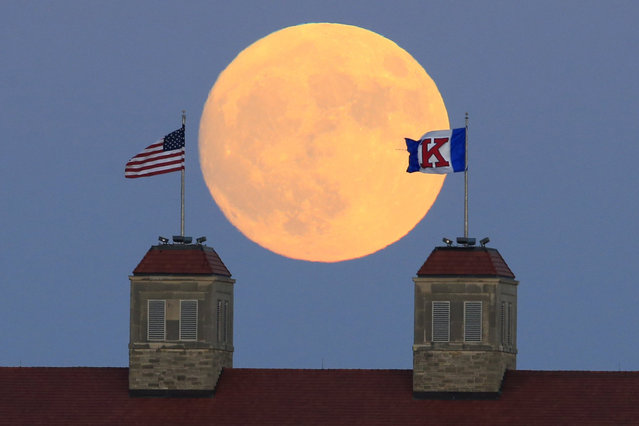
The moon rises beyond flags atop Fraser Hall on the University of Kansas campus in Lawrence, Kan., Sunday, November 13, 2016. Monday morning's supermoon was to be the closest a full moon has been to Earth since Jan. 26, 1948. (Photo by Orlin Wagner/AP Photo)
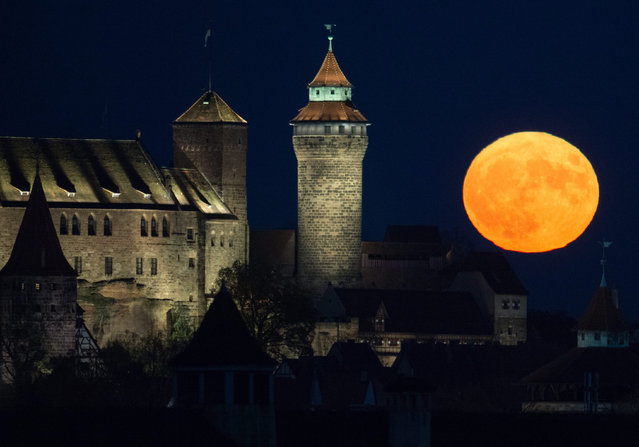
The full moon rises behind the Kaiserburg castle in Nuremberg, Germany, 14 November 2016.The moon is the largest full moon since 1948 also known as the “supermoon”, when the moon reaches its closest point to Earth. The next time the moon will be this close will be on 25 November 2034. (Photo by Timm Schamberger/EPA)
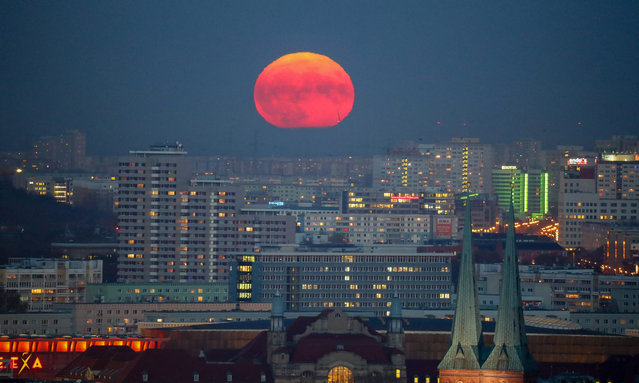
The colourful moon rises above Berlin, Germany, 14 November 2016. The moon is the largest full moon since 1948 also known as the “supermoon”, when the moon reaches its closest point to Earth. The next time the moon will be this close will be on 25 November 2034. (Photo by Kay Nietfeld/EPA)
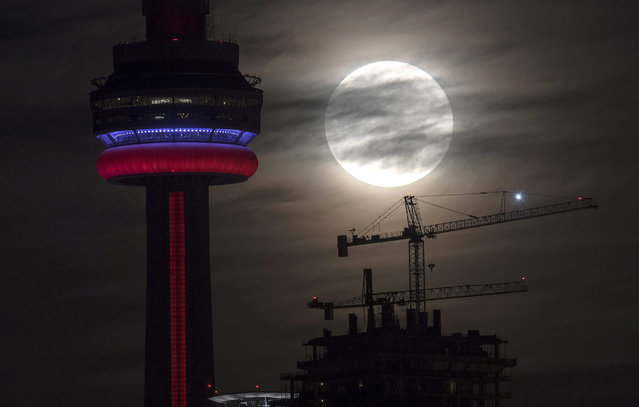
The supermoon sets behind the CN tower in Toronto on Monday, November 14, 2016. The brightest moon in almost 69 years lights up the sky this week in a treat for star watchers around the globe. The phenomenon is known as the supermoon. (Photo by Frank Gunn/The Canadian Press via AP Photo)
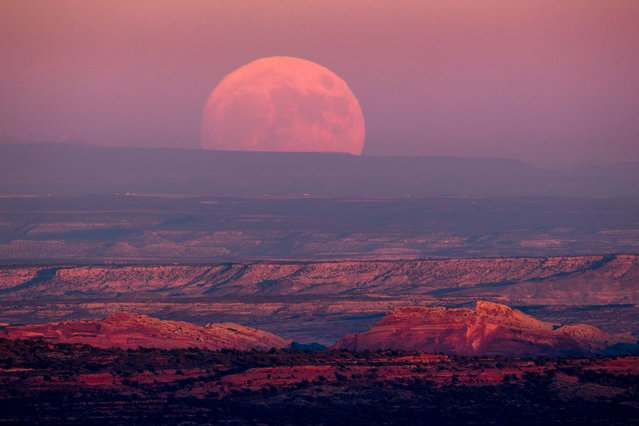
A nearly full moon rises above the Valley of the Gods near Mexican Hat, Utah, USA, 13 November 2016. November will see the largest full moon since 1948, also known as the “supermoon”, when the moon reaches its closest point to Earth and becomes full at 8:52 AM EST, 13:52 UTC on 14 November. The next time the moon will be this close will be on 25 November 2034. (Photo by Jim Lo Scalzo/EPA)
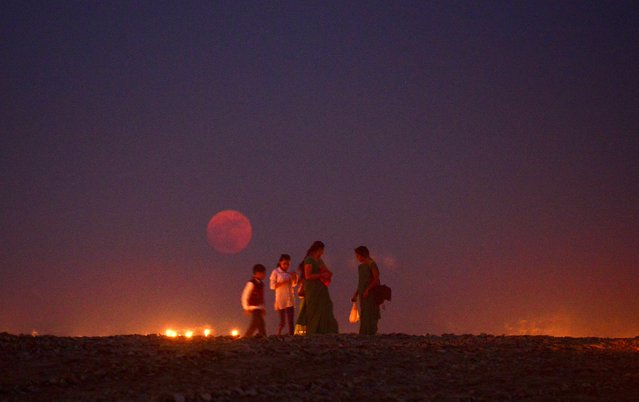
Indian people walk at Sangam as the “supermoon” rises in Allahabad on November 14, 2016. Skygazers headed to high-rise buildings, ancient forts and beaches on November 14 to witness the closest “supermoon” to Earth in almost seven decades, hoping for dramatic photos and spectacular surf. The moon will be the closest to Earth since 1948 at a distance of 356,509 kilometres (221,524 miles), creating what NASA described as “an extra-supermoon”. (Photo by Sanjay Kanojia/AFP Photo)
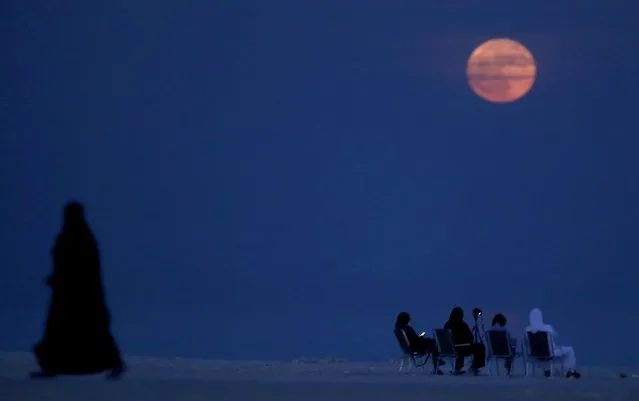
Kuwaitis observe the “supermoon” spectacle in Kuwait City on November 14, 2016. The moon is at its closest position to earth since 1948, making the moon the brightest in nearly 69 years. The Super moon phenomenon happens when the moon is at its closest to earth. (Photo by Yasser Al-Zayya/AFP Photo)

A “supermoon” is seen rising beyond a ferris wheel in Hong Kong on November 14, 2016. Skygazers headed to high-rise buildings, ancient forts and beaches on November 14 to witness the closest “supermoon” to Earth in almost seven decades, hoping for dramatic photos and spectacular surf. The moon will be the closest to Earth since 1948 at a distance of 356,509 kilometres (221,524 miles), creating what NASA described as “an extra-supermoon”. (Photo by Anthony Wallace/AFP Photo)
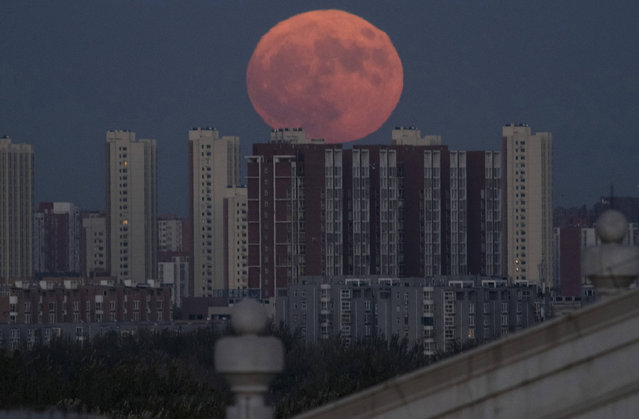
The moon rises from behind apartment buildings in Beijing, China, Monday, November 14, 2016. The brightest moon in almost 69 years will be lighting up the sky this week in a treat for star watchers around the globe. (Photo by Ng Han Guan/AP Photo)

The moon rises over Victoria Harbour in Hong Kong, Monday, November 14, 2016. The brightest moon in almost 69 years lights up the sky this week in a treat for star watchers around the globe. The phenomenon is known as the supermoon. The tall building is the International Commerce Centre. (Photo by Kin Cheung/AP Photo)
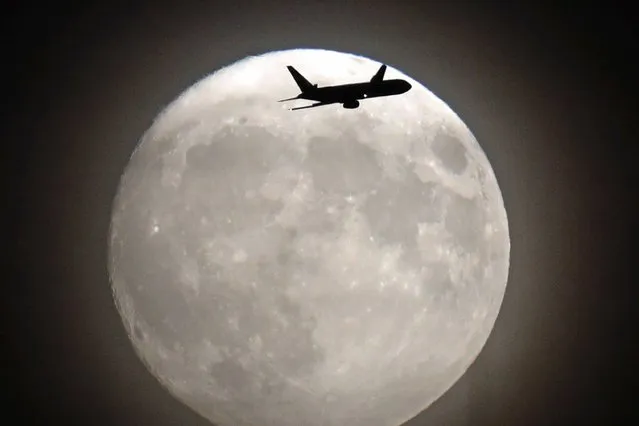
A commerical jet flies in front of the moon on its approach to Heathrow airport in west London on November 13, 2016. Tomorrow, the moon will orbit closer to the earth than at any time since 1948, named a “supermoon”, it is defined by a Full or New moon coinciding with the moon's closest approach to the Earth. (Photo by Adrian Dennis/AFP Photo)
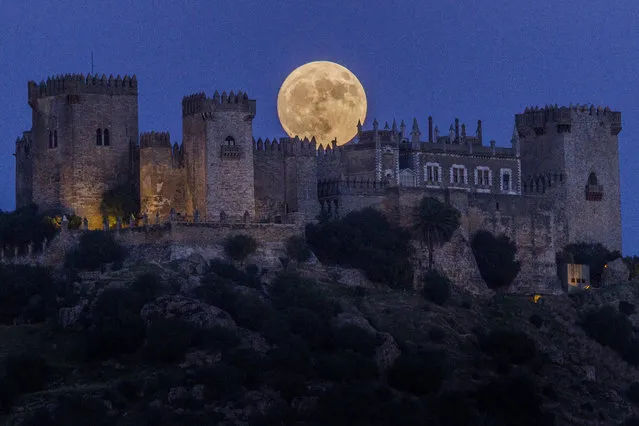
The moon rises behind the castle of Almodovar in Cordoba, southern Spain, on Sunday, November 13, 2016. The Supermoon on November 14, 2016, will be the closest a full moon has been to Earth since January 26, 1948. (Photo by Miguel Morenatti/AP Photo)
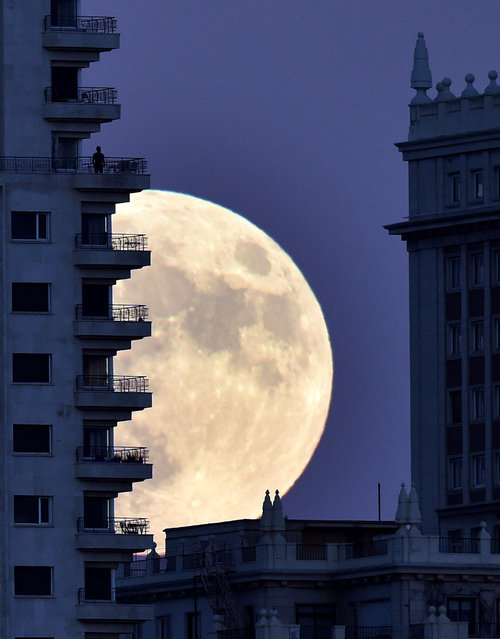
A man stands on a balcony of a building of Madrid as the moon rises in background, on November 13, 2016, on the eve of a “supermoon”. On November 14, 2016, the moon will orbit closer to the earth than at any time since 1948, named a “supermoon”, it is defined by a Full or New moon coinciding with the moon's closest approach to the Earth. (Photo by Gerard Julien/AFP Photo)
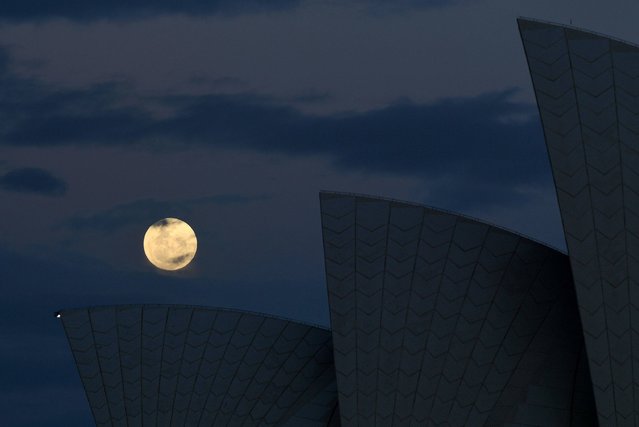
The “supermoon” rises over the sails of the Sydney Opera House on November 14, 2016. Skygazers headed to high-rise buildings, ancient forts and beaches on November 14 to witness the closest “supermoon” to Earth in almost seven decades, hoping for dramatic photos and spectacular surf. The moon will be the closest to Earth since 1948 at a distance of 356,509 kilometres (221,524 miles), creating what NASA described as “an extra-supermoon”. (Photo by William West/AFP Photo)
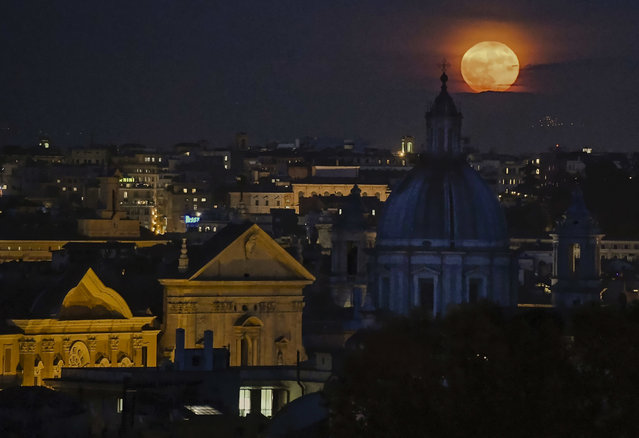
A full moon rises over the Rome's skyline, Monday, November 14, 2016. Monday's supermoon, a phenomenon that happens when the moon is visible in full as it makes a close pass at the earth, is the closest to earth since 1948. (Photo by Alessandro Di Meo/ANSA via AP Photo)
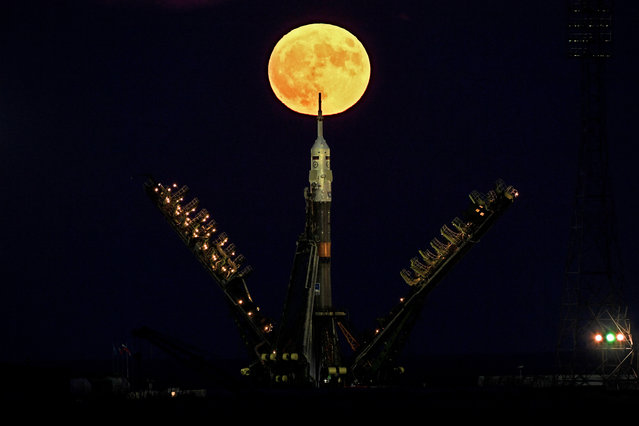
The supermoon is seen behind the Soyuz MS-03 spacecraft set on the launch pad at the Russian-leased Baikonur cosmodrome in Kazakhstan on November 14, 2016. (Photo by Kirill Kudryavtsev/AFP Photo)
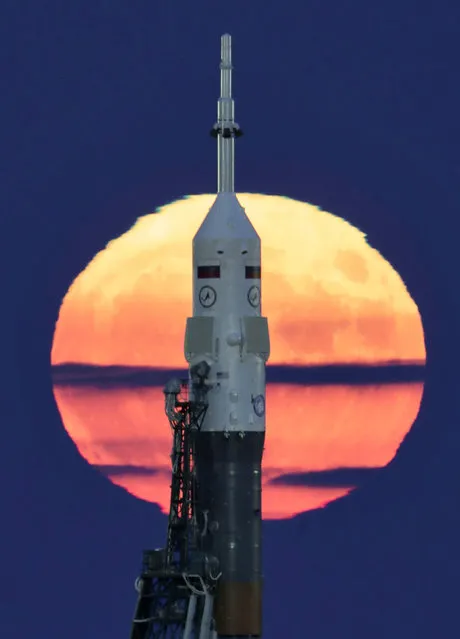
The supermoon backdrops Russia's Soyuz-FG booster rocket with the Soyuz MS-03 space ship that will carry new crew to the International Space Station (ISS) installed at the launch pad at the Russian leased Baikonur cosmodrome, Kazakhstan, Monday, November 14, 2016. (Photo by Dmitri Lovetsky/AP Photo)
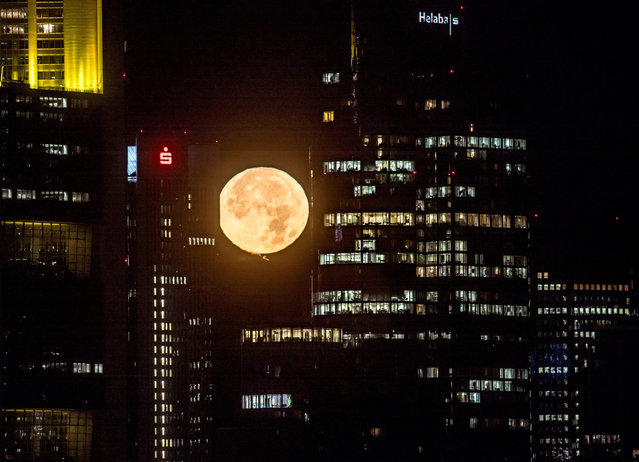
The moon rises over Frankfurt am Main, Germany, early 14 November 2016. November will see the largest full moon since 1948, also known as the “supermoon”, when the moon reaches its closest point to Earth and becomes full at 8:52 AM EST, 13:52 UTC on 14 November. The next time the moon will be this close will be on 25 November 2034. (Photo by Frank Rumpenhorst/EPA)
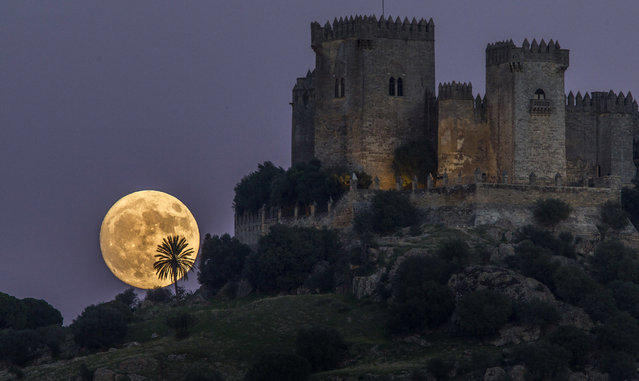
The moon rises behind the castle of Almodovar in Cordoba, southern Spain, on Sunday, November 13, 2016. The Supermoon on November 14, 2016, will be the closest a full moon has been to Earth since January 26, 1948. (Photo by Miguel Morenatti/AP Photo)
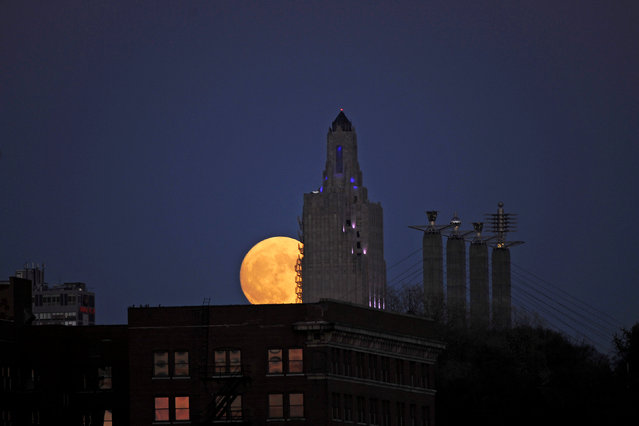
The “supermoon”, the closest the moon comes to Earth since 1948, rises over the Power and Light building in downtown Kansas City, Missouri, U.S., November 13, 2016. (Photo by Dave Kaup/Reuters)
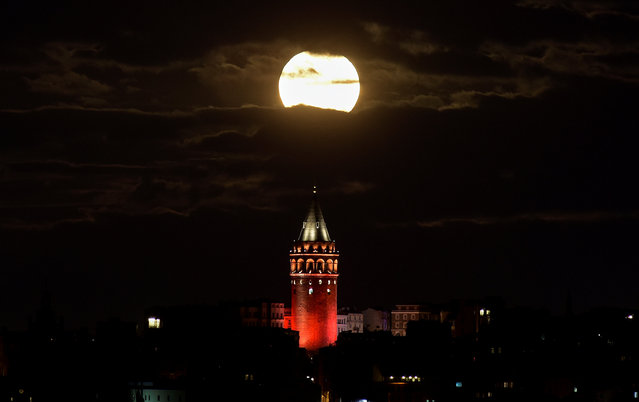
The supermoon is seen over the historical Galata Tower in Istanbul, Turkey, early November 14, 2016. (Photo by Yagiz Karahan/Reuters)
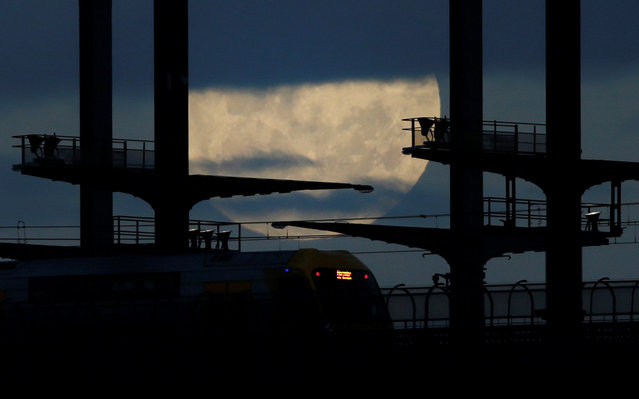
A commuter train en route to the suburb of Hornsby crosses on the Sydney Harbor Bridge under the Super Moon, November 14, 2016. (Photo by Jason Reed/Reuters)
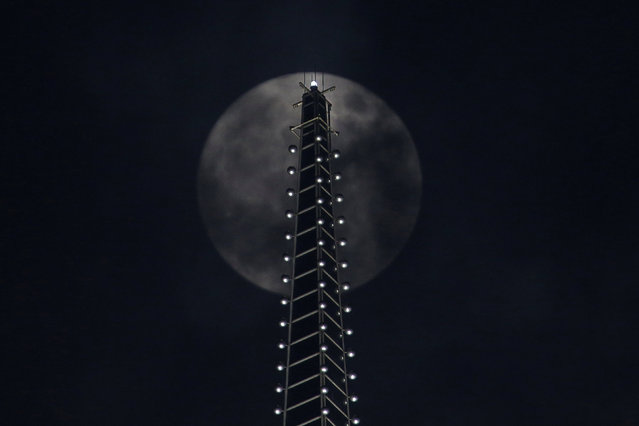
The supermoon is seen behind a building in Shanghai, China November 14, 2016. (Photo by Aly Song/Reuters)
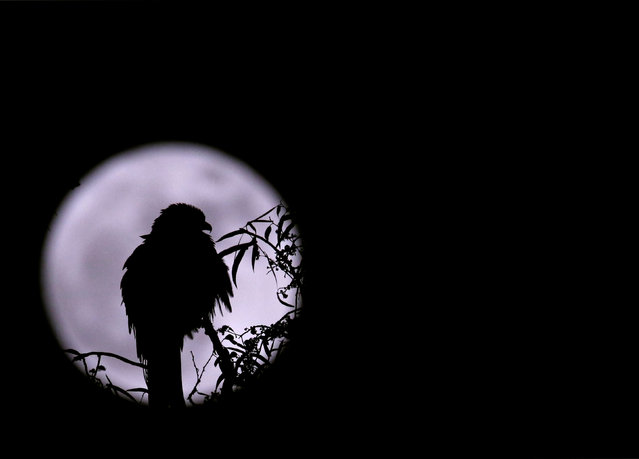
An eagle is silhouetted against the “supermoon” in Kathmandu, Nepal November 14, 2016. (Photo by Navesh Chitrakar/Reuters)
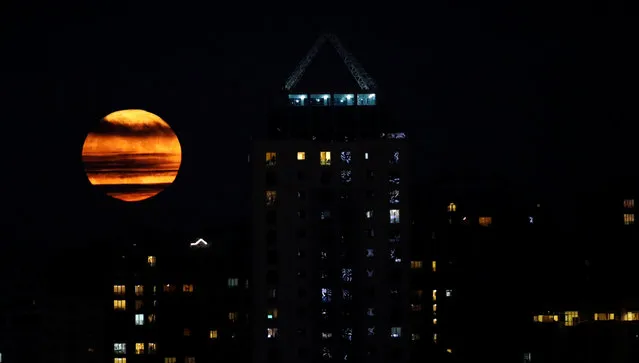
The supermoon is seen in Istanbul, Turkey November 14, 2016. (Photo by Umit Bektas/Reuters)
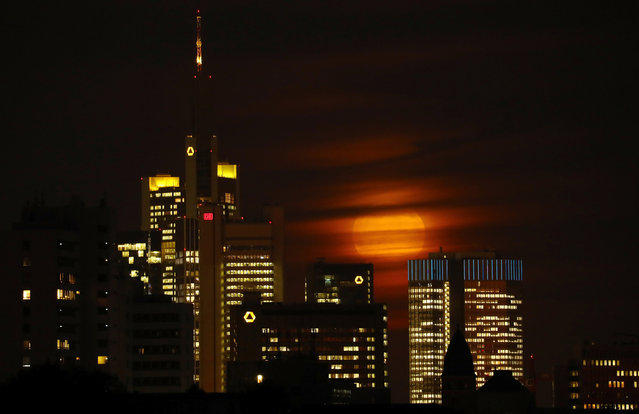
The moon is partly covered by clouds as it rises above the skyline of Frankfurt behind the headquarters of Germany's Commerzbank, in Germany, early evening November 14, 2016. (Photo by Kai Pfaffenbach/Reuters)
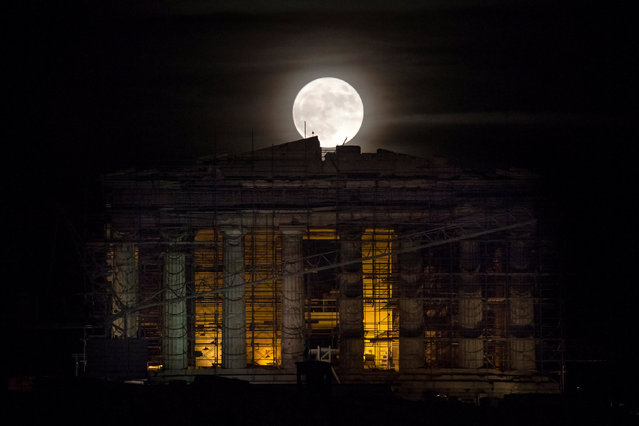
A rising “supermoon” is seen over the Parthenon temple atop the ancient Acropolis hill in Athens, Greece November 14, 2016. (Photo by Alkis Konstantinidis/Reuters)
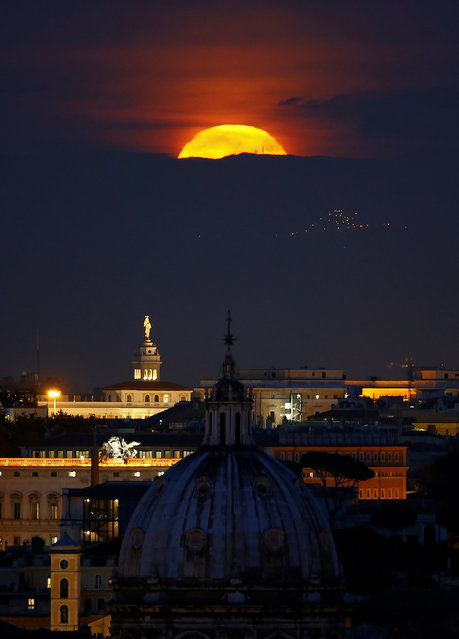
The moon rises on the day of the “supermoon” spectacle in Rome, Italy November 14, 2016. (Photo by Tony Gentile/Reuters)
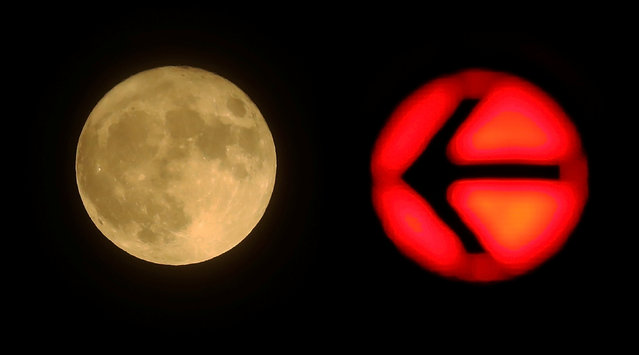
A red traffic light is seen next to the moon in downtown Frankfurt, Germany November 14, 2016. (Photo by Kai Pfaffenbach/Reuters)
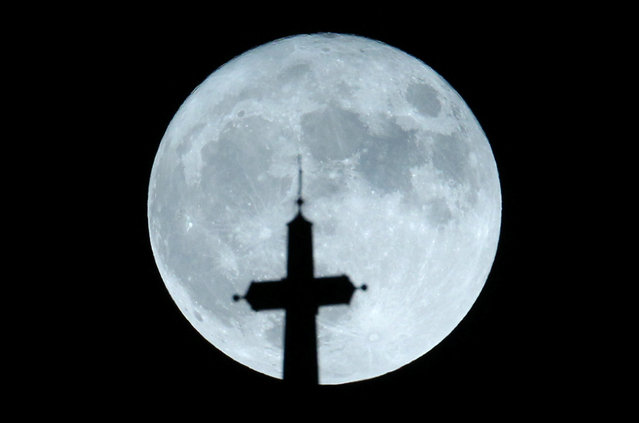
The supermoon is seen behind the cathedral cross in Zagreb, Croatia November 14, 2016. (Photo by Antonio Bronic/Reuters)
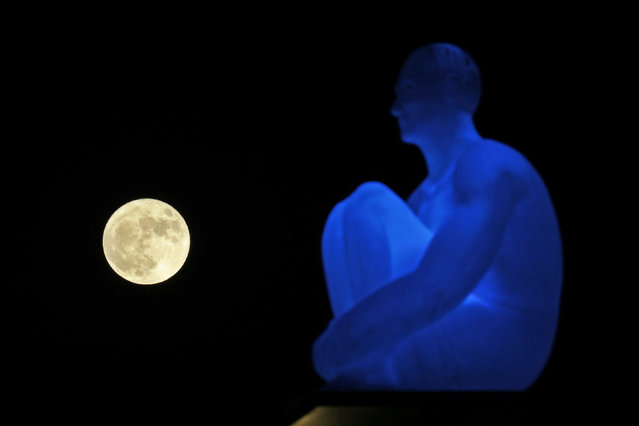
The supermoon rises behind one of the seven statues by spanish artist Jaume Plensa on Massena square in Nice, France, November 14, 2016. (Photo by Eric Gaillard/Reuters)
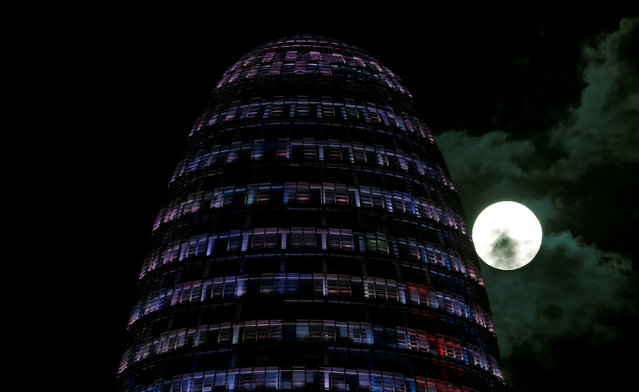
The supermoon rises behind the Agbar Tower in Barcelona, Spain November 14, 2016. (Photo by Albert Gea/Reuters)
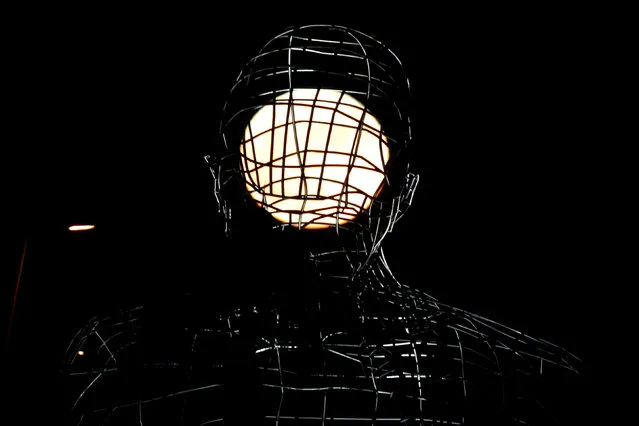
The supermoon rises behind “El Pensador” (The Thinker) in Dos Hermanas, near Seville, southern Spain November 14, 2016. (Photo by Jon Nazca/Reuters)
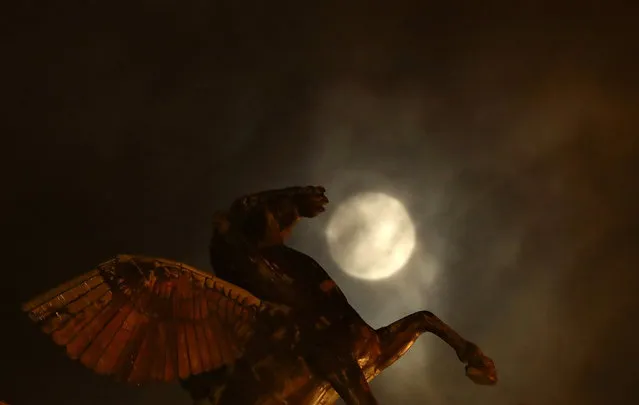
The moon is partly covered by clouds as it rises behind the pegasus statue on top of the old opera house in downtown Frankfurt, Germany, November 14, 2016. (Photo by Kai Pfaffenbach/Reuters)
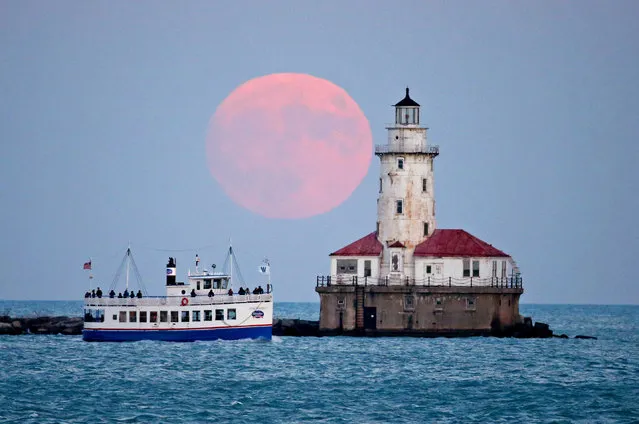
The moon rises over the Chicago, US harbour lighthouse on the eve of the supermoon on November 13, 2016. (Photo by Jerry Lai/ddp USA/Rex Features/Shutterstock)
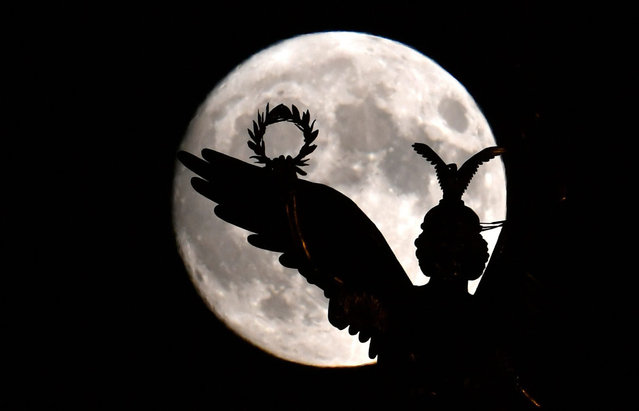
The figure of Viktoria with her laurel wreath on the victory column stands out against the full moon in Berlin, Germany, 13 November 2016. (Photo by Ralf Hirschberger/EPA)
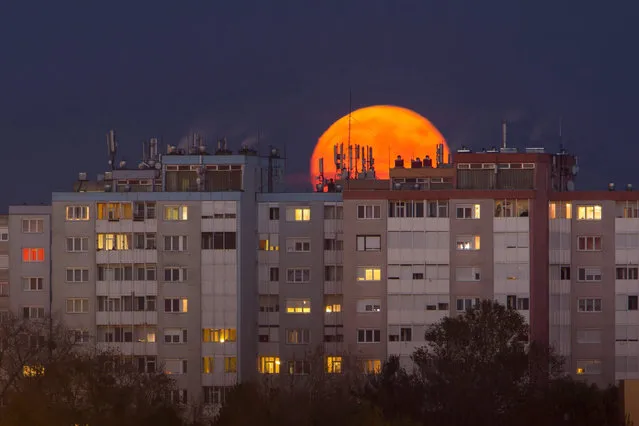
The so-called super full moon shining in the sky above the town of Nagykanizsa, 208 kms southwest of Budapest, Hungary, 14 November 2016. The moon is the largest full moon since 1948 also known as the “supermoon”, when the moon reaches its closest point to Earth. The next time the moon will be this close will be on 25 November 2034. (Photo by Gyorgy Varga/EPA)
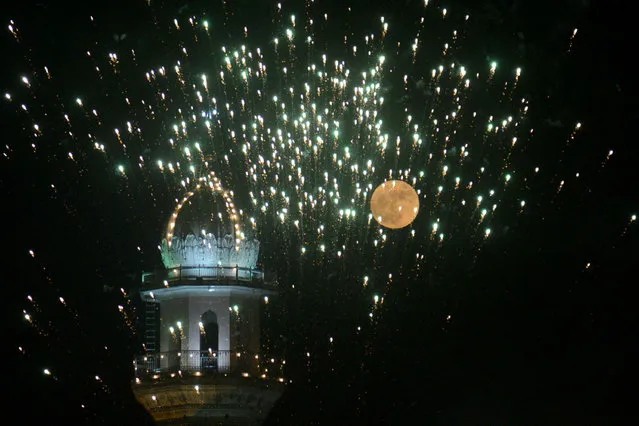
The “supermoon” rises over the Sikh Shrine, the Golden Temple in Amritsar, India on November 14, 2016. (Photo by Narinder Nanu/AFP Photo)
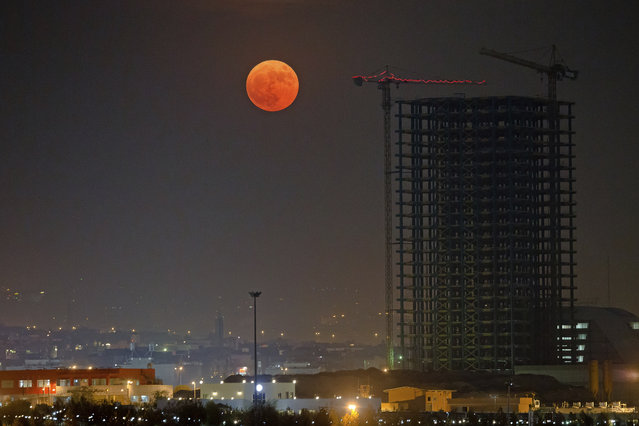
The moon rises over Tehran in Iran, Monday, November 14, 2016. The brightest moon in almost 69 years lit up the sky, during its closest approach to earth as the “Supermoon” reached its most luminescent phase. The moon won't be this close again until Nov. 25, 2035. (Photo by Ebrahim Noroozi/AP Photo)
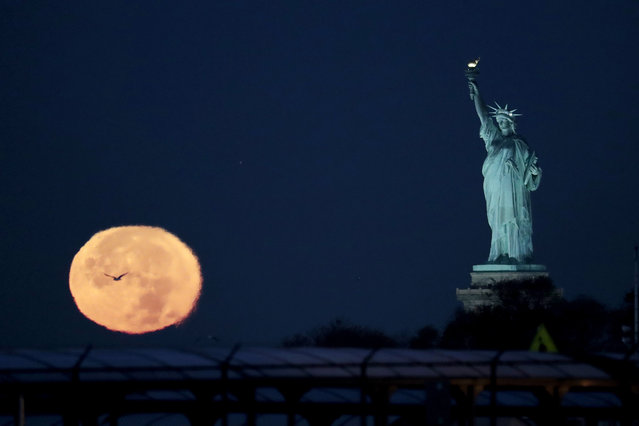
The supermoon appears near the Statue of Liberty, Monday, November 14, 2016, in New York. Monday's supermoon, a phenomenon that happens when the moon makes a close pass at the earth, is the closest to earth since 1948. (Photo by Julio Cortez/AP Photo)
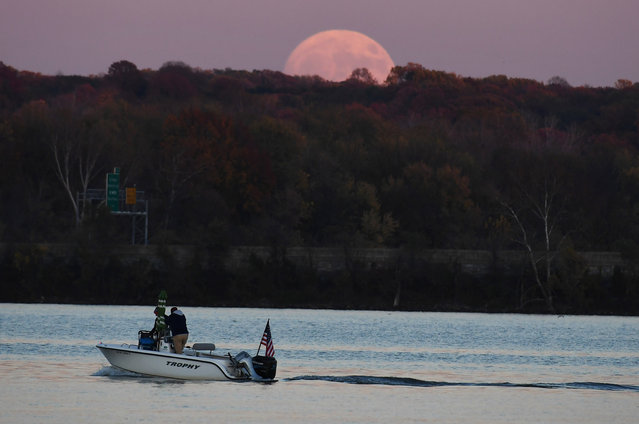
A boat glides along the Potomac River as the moon rises on Sunday November 13, 2016 in Alexandria, VA. (Photo by Matt McClain/The Washington Post)
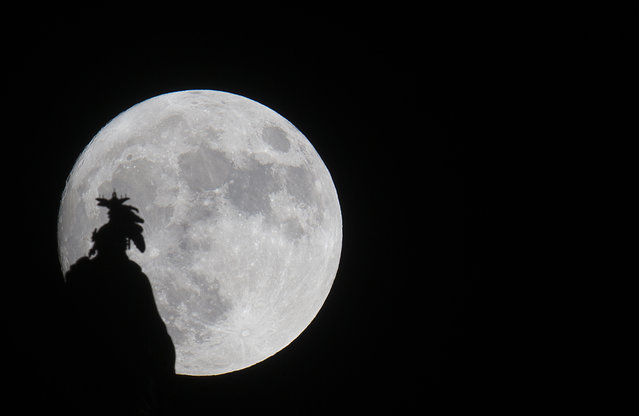
A supermoon rises over the Statue of Freedom on the Capitol dome in Washington, DC November 13, 2016. The supermoon will venture to its closest point in 68 years, leaving only 221,524 miles (356,508 km) between Earth and the moon. (Photo by Andrew Caballero-Reynolds/AFP Photo)
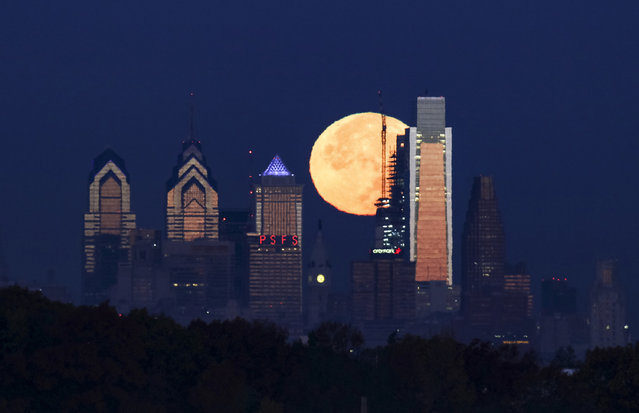
The supermoon sets behind the Philadelphia skyline on Monday, November 14, 2016. The brightest moon in almost 69 years lights up the sky this week in a treat for star watchers around the globe. The phenomenon is known as the supermoon. (Photo by Joseph Kaczmarek/AP Photo)
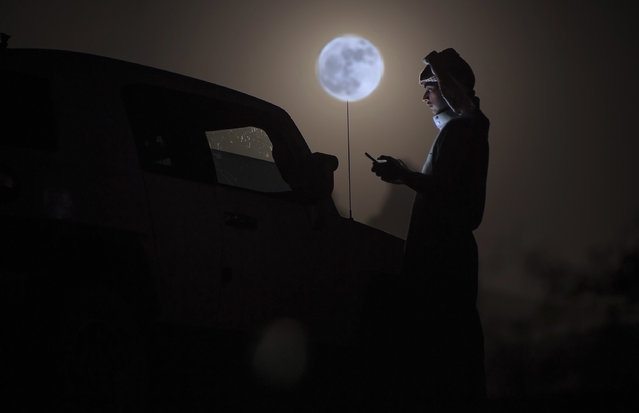
A man looks at his phone as a “supermoon” rises over the desert near Tabuk, some 1500 kilometers northwest of the Saudi capital Riyadh, on November 14, 2016. The phenomenon happens when the moon is full at the same time as, or very near, perigee – its closest point to Earth on an elliptical, monthly orbit. It was the closest to Earth since 1948 at a distance of 356,509 kilometres (221,524 miles), creating what NASA described as “an extra-supermoon”. (Photo by Mohammed Albuhaisi/AFP Photo)
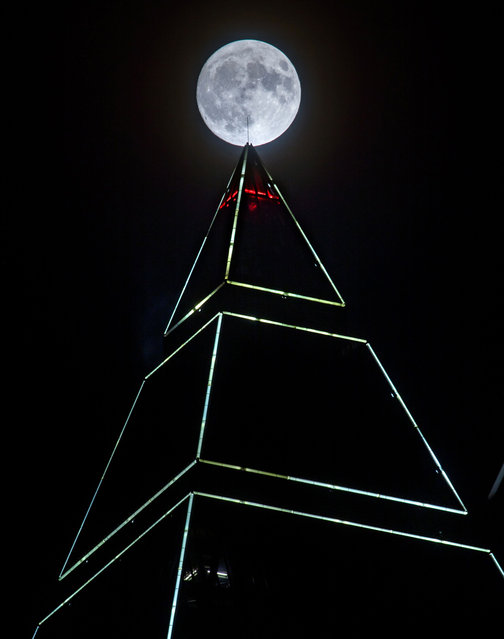
Full moon appears behind the Messeturm tower in Frankfurt am Main, western Germany, on November 13, 2016. Skygazers will be heading to high-rise buildings, ancient forts and beaches to witness the closest “supermoon” to Earth in almost seven decades, hoping for dramatic photos and spectacular surf. The unusually big and bright Moon will appear at its most impressive just as night falls over Asia, but astronomy enthusiasts will be able to see Earth's satellite loom large anywhere in the world shortly after sunset, weather permitting. (Photo by Frank Rumpenhorst/AFP Photo/DPA)
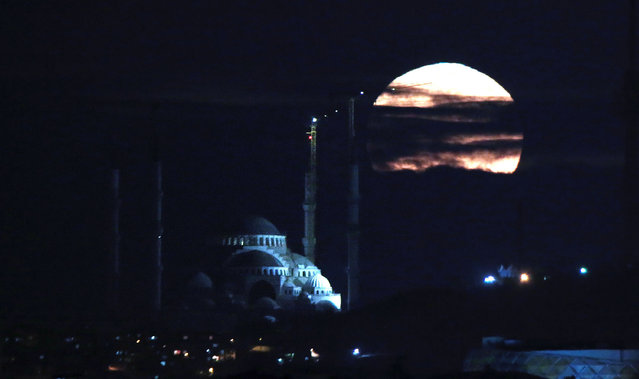
Supermoon rises over Istanbul, Turkey on November 14, 2016. The moon sets biggest, closest and brightest since 1948. The last supermoon was seen in 1948, when the moon reached its closed point to earth. According to a statement from NASA, the next time super moon will be this close will be on 25 November 2034. (Photo by Ahmet Dumanli/Anadolu Agency/Getty Images)
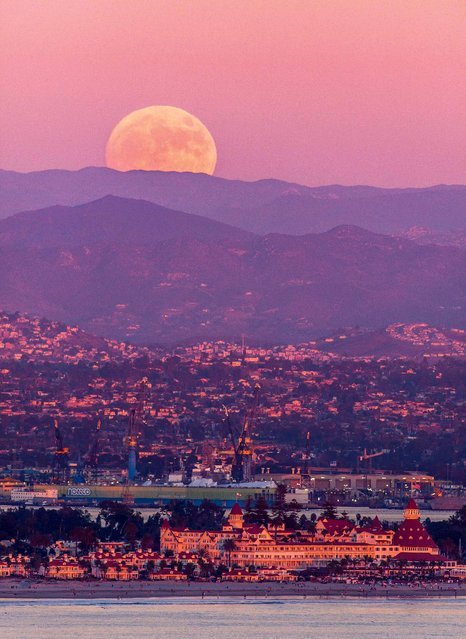
The supermoon rises over pink-hued mountains near San Diego in California, USA on November 13, 2016. Supermoons occur about once every 14 months on average. However, Sunday night's supermoon is extra super because the moon will be even closer to Earth than usual. At its closest approach, the moon will be 221,524 miles from our planet, compared with an average distance of 238,900 miles. The last time the moon sailed this close to Earth was on Jan. 26, 1948, when it came 30 miles closer. (Photo by Daren Fentiman/ZUMA Wire/Rex Features/Shutterstock)
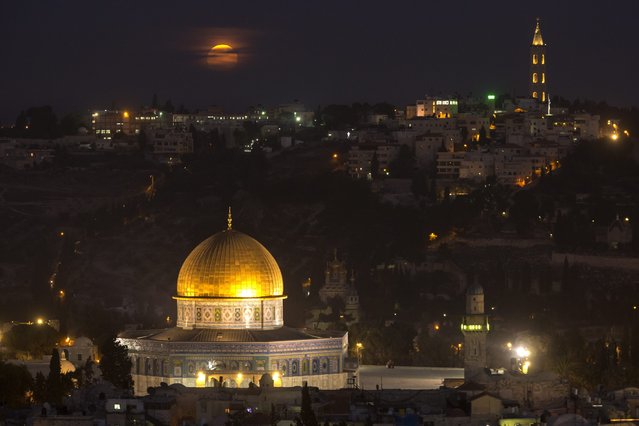
The Super Moon rises above the Old city of Jerusalem with its distinctive golden Dome of the Rock on the Hareem el-Sharif (The Noble Sanctuary), or the Temple Mount, in Jerusalem, Israel, 14 November 2016. Behind is the Arab neighborhood of The Mount of Olives and the Russian Church in A-Tur. (Photo by Jim Hollander/EPA)
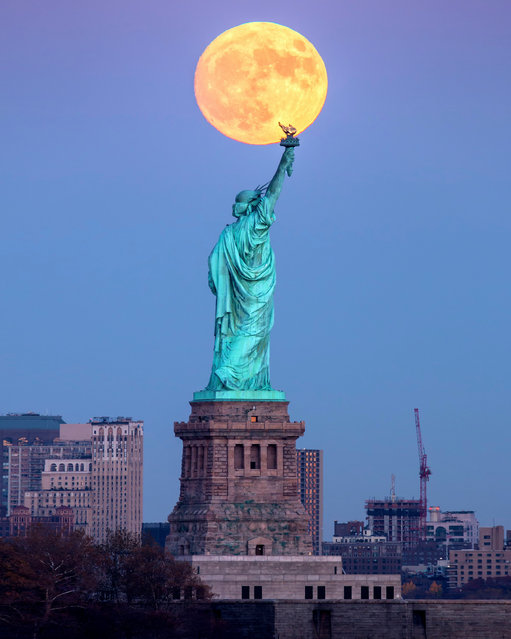
This photo shows a supermoon over the Statue of Liberty in New York City on Monday, November 14, 2016. (Photo by Peter Alessandria/Caters News)
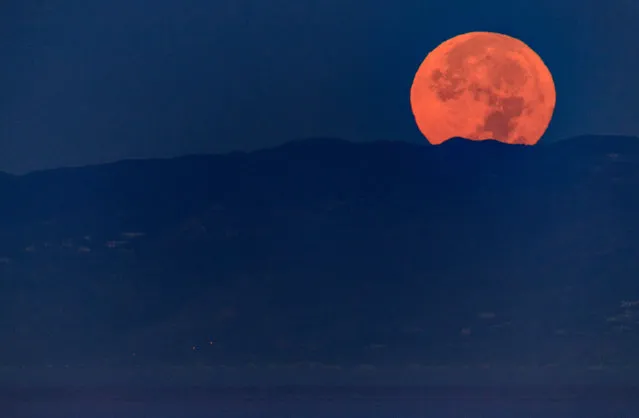
The moon sets during its closest orbit to the Earth since 1948 on November 14, 2016 in Venice Beach, California. The so-called Supermoon appears up to 14 percent bigger and 30 percent brighter as it comes about 22,000 miles closer to the Earth than average, though to the casual observer, the increase appears slight. (Photo by Christopher Polk/Getty Images)
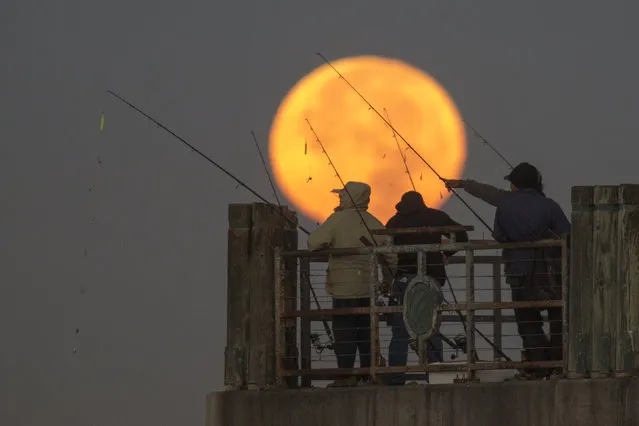
The moon sets behind people fishing on a pier during its closest orbit to the Earth since 1948 on November 14, 2016 in Redondo Beach, California. The so-called supermoon appears up to 14 percent bigger and 30 percent brighter as it comes about 22,000 miles closer to the Earth than average, though to the casual observer, the increase appears slight. (Photo by David McNew/Getty Images)
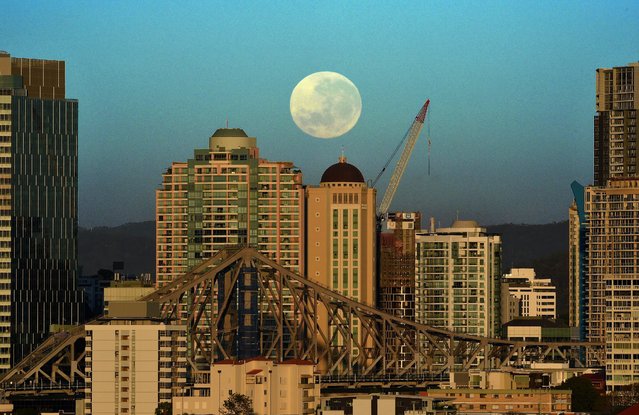
A Supermoon sets over the Brisbane skyline, Australia, early 15 November 2016. The event occurs when a full or new moon passes closer to Earth in its monthly orbit with this particular one being the closest full moon to date in the 21st century according to NASA. (Photo by Dan Peled/EPA)
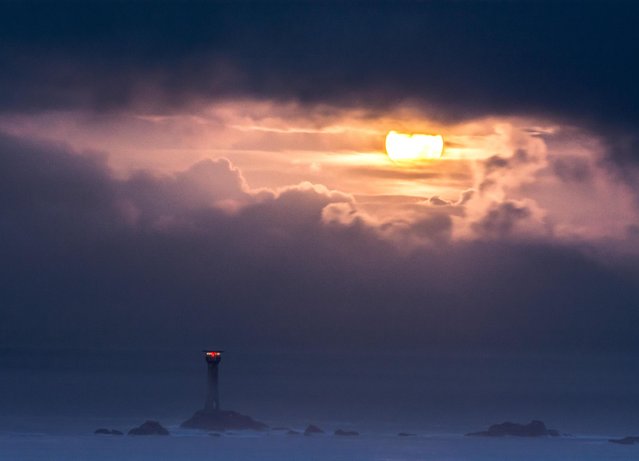
The Supermoon sets over the Longships lighthouse at Lands End, Cornwall, UK on November 14, 2016, before it's final rising later on today. Clouds are threatening to obscure the view in much of the south west. (Photo by Simon Maycock/Alamy Live News)
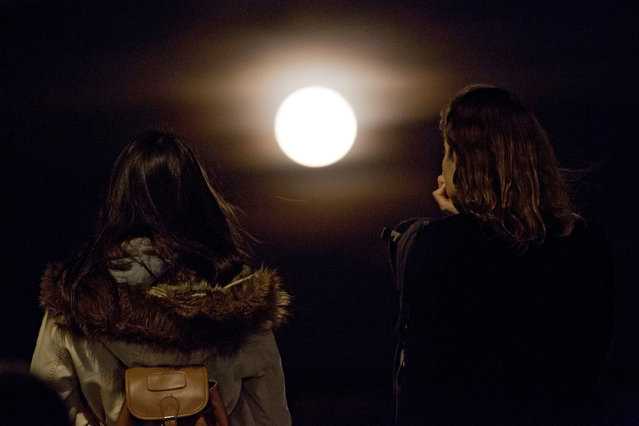
Two women watch the full moon rise above Lisbon Monday, November 14 2016. The brightest moon in almost 69 years, a phenomenon known as the supermoon, is lighting up the sky in a treat for star watchers around the globe. (Photo by Armando Franca/AP Photo)
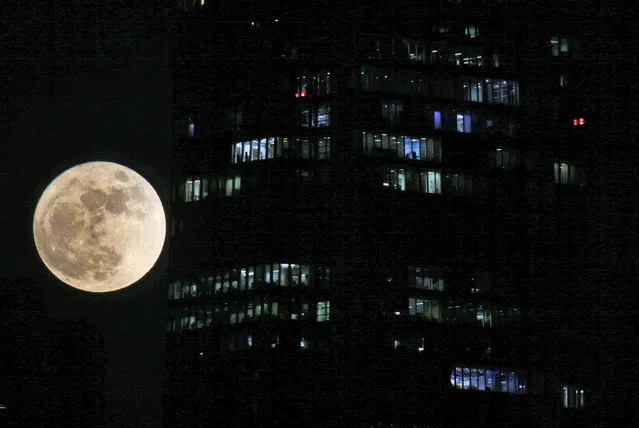
The supermoon rises over the city skyline in Dubai, United Arab Emirates, Monday, November 14, 2016. (Photo by Kamran Jebreili/AP Photo)
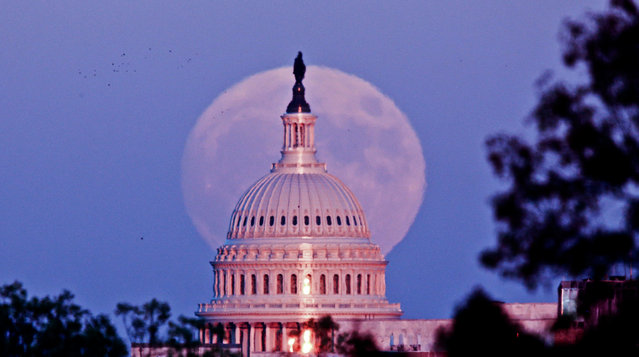
The moon rises behind the U.S. Capitol in Washington, D.C., November 13, 2016. (Photo by Bill Workinger)
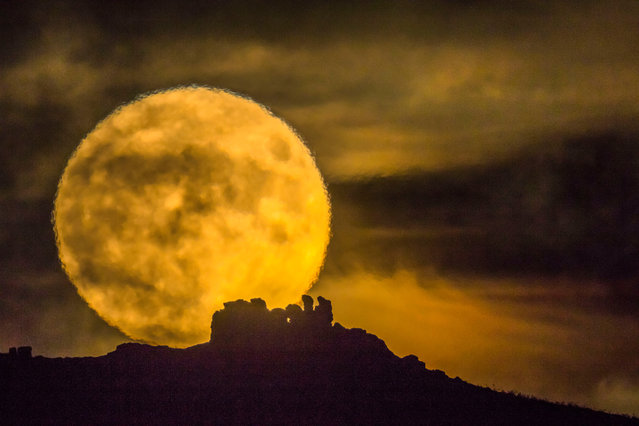
Photographer Andrew Fusek Peters captured a striking image of the moon appearing enormous as it rose over Caer Caradoc in Shropshire, England on November 14, 2016. (Photo by Andrew Fusek Peters/Mercury Press)
15 Nov 2016 11:30:00,
post received
0 comments
